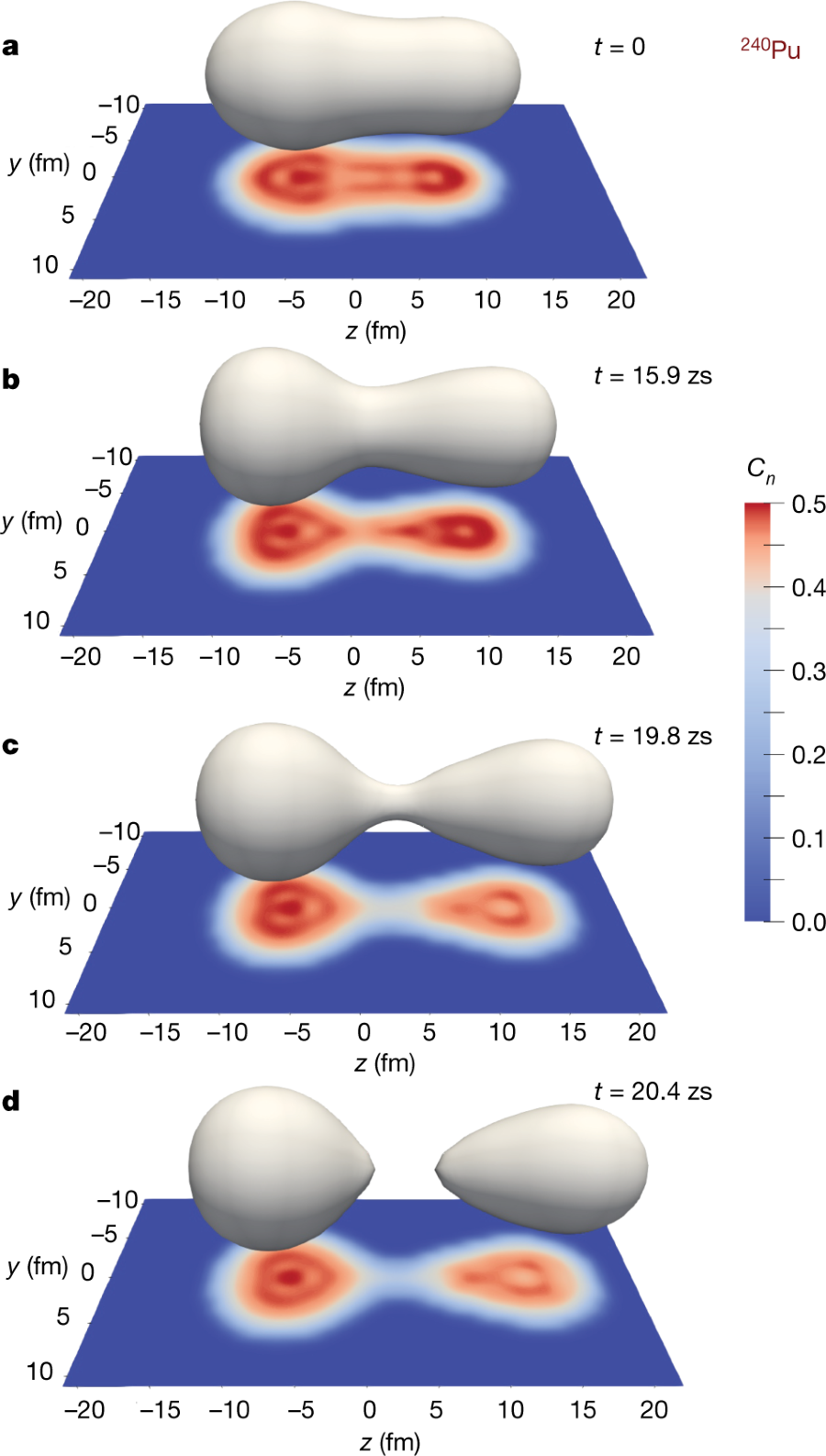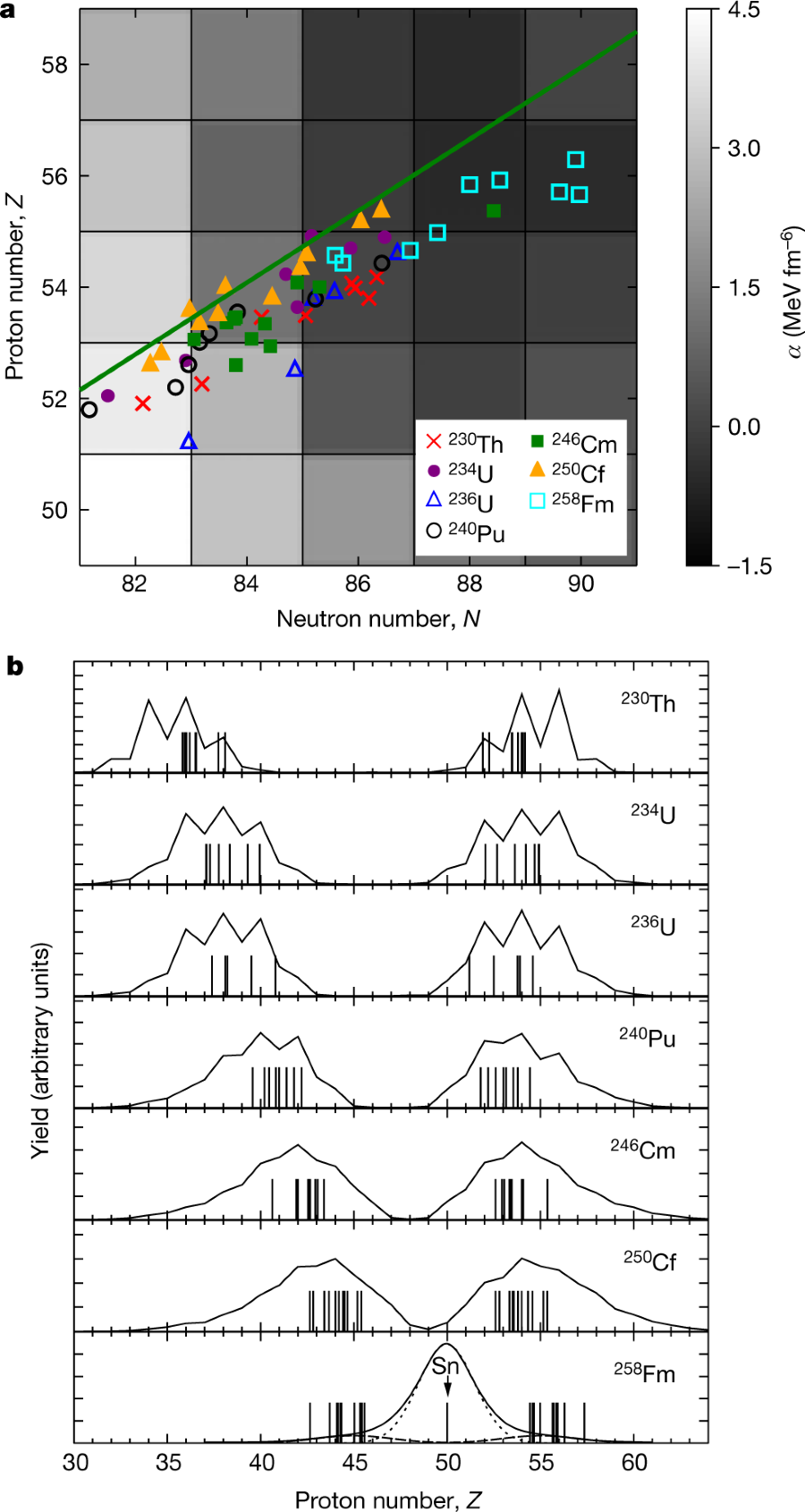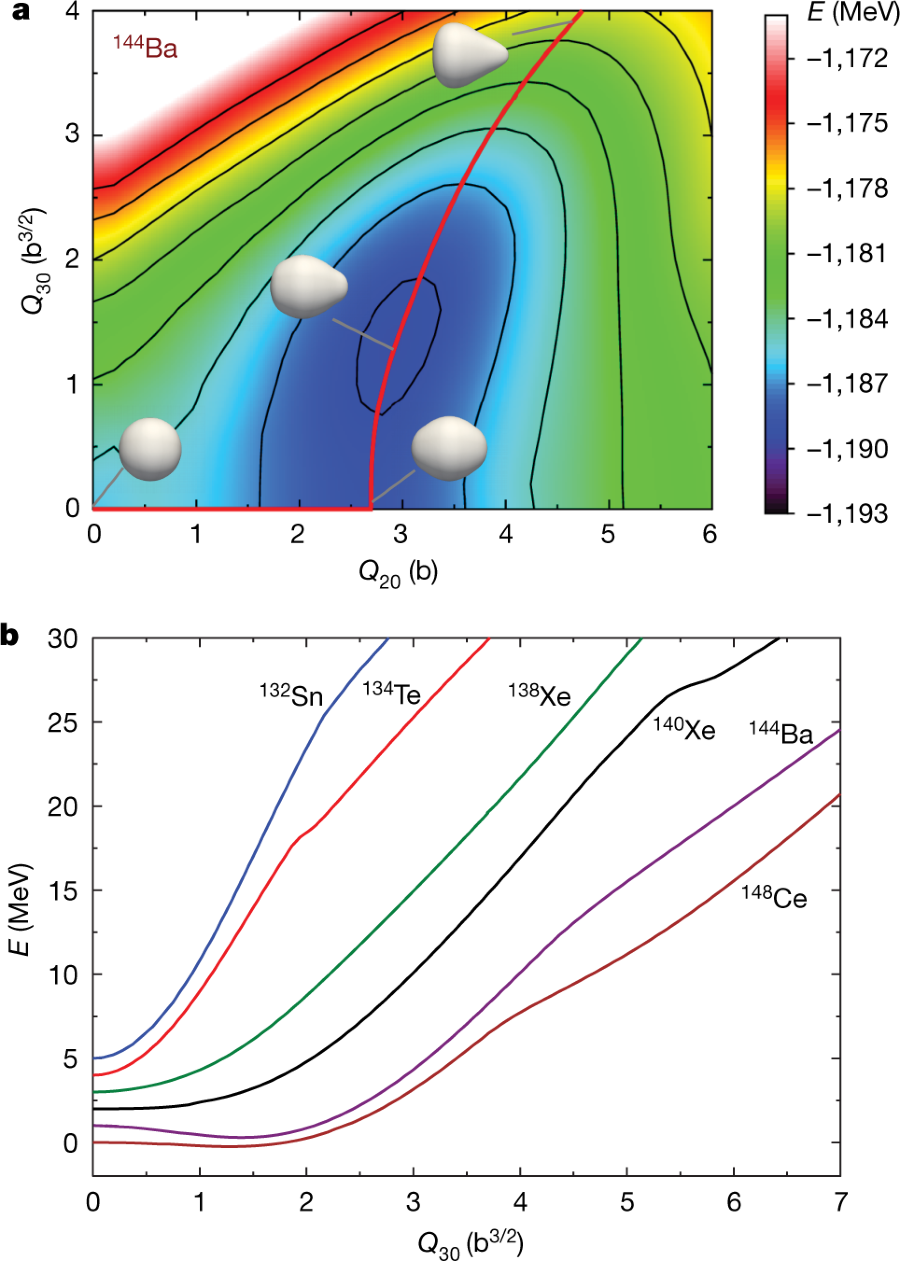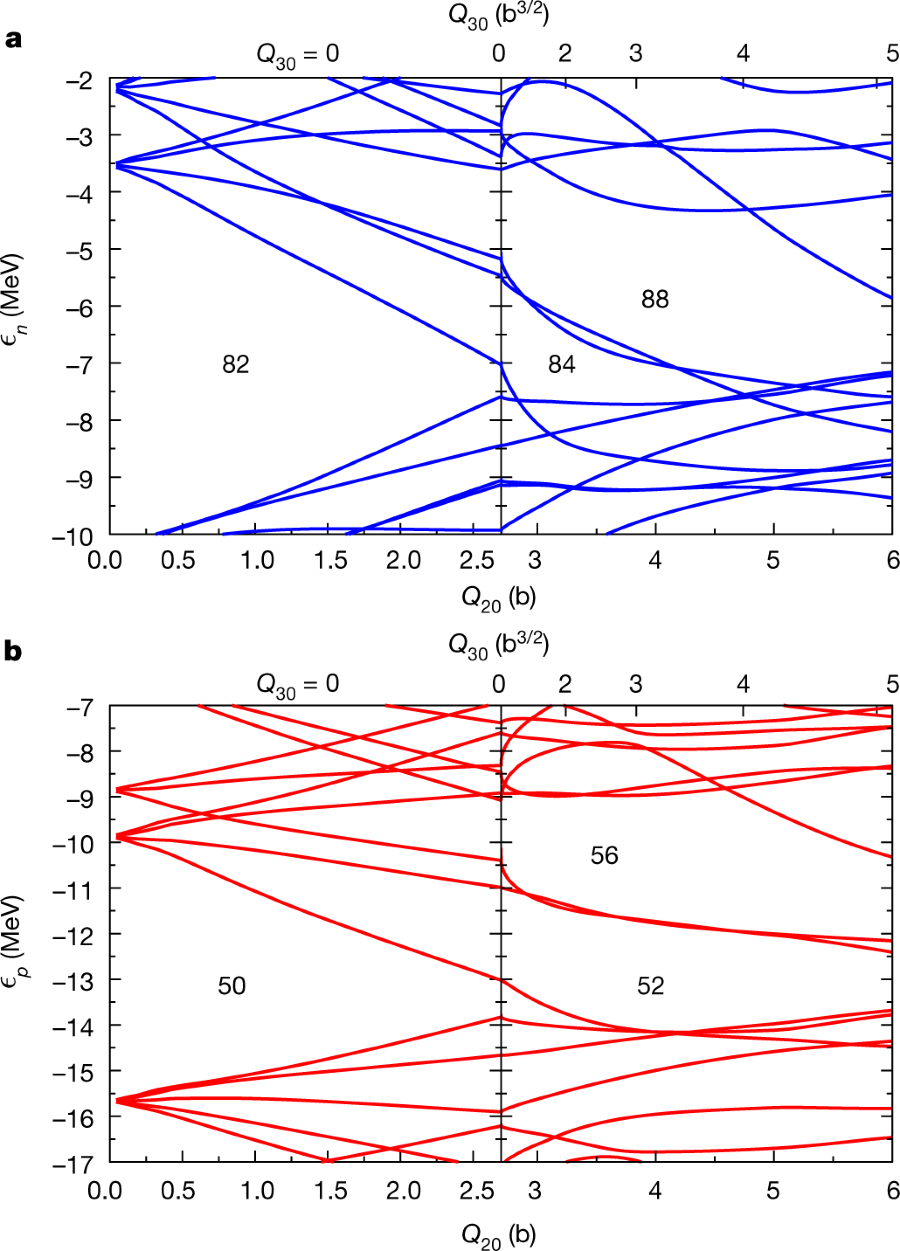Science
Related: About this forumTheoretical Analysis of the Observed Asymmetry in the Fission of Actinides.
The paper I'll discuss in this post is this one: Impact of pear-shaped fission fragments on mass-asymmetric fission in actinides (Guillaume Scamps & Cédric Simenel, Nature 564, 382–385 (2018))
Used nuclear fuel is very interesting stuff purely from a chemist's perspective because of the wide distribution of elements in it. This, in my view, is a good thing, because it allows the recovery of lots of elements with potential for utilization in the solution of extremely important situations. For example, it has been argued - I've referred to this often in places I've written on the internet - that the world supply of the valuable and technologically important element rhodium available from used nuclear fuel will shortly exceed that available from ores. (cf. Electrochimica Acta 53, 6, 2008, Pages 2794-2801) The exactly symmetric fission of plutonium would give an isotope of silver with 118 or 119 neutrons which would rapidly decay - owing to a large neutron excess - to a stable isotope of tin, 118Sn. Tin is a useful element, but nowhere near as valuable as rhodium.
The fission product distribution (with mass numbers for the abscissa) for plutonium-239 is shown here:
 ?w=444&h=389
?w=444&h=389
I've been thinking about used nuclear fuels - "nuclear waste" in the parlance of people with far too limited imaginations - for a very long time, but I never paused to think about why the actinide elements - at least up to element 100, Fermium which does almost perfectly undergo symmetric fission - fission in an asymmetric fashion.
The paper cited at the outset addresses this issue.
From the abstract:
From the paper's introduction:
Although progress has been made recently in describing fission-fragment mass distributions with stochastic approaches9,10, theoretical description of the first stage of fission, from the ground-state deformation to the fission barrier, remains a challenge11. However, the study of the dynamics along the fission valleys is now possible with the time-dependent energy-density functional approach12,13 including nuclear superfluidity7,14,15
Heavy nuclei have long been treated as fluids, beginning with the work of Neils Bohr and George Gamow who described heavy nuclei using the "liquid drop" model. This model was used by Lise Meitner and her nephew Otto Frisch to discover nuclear fission using the laboratory results of Otto Hahn. In this model, these drops deform, and sometimes they deform so much that the electrostatic repulsion of protons in their nuclei overcomes the very locally acting strong nuclear force.
From the paper:
Figure 1:

The caption:
The authors use certain computational quantum mechanical calculation programs (Hartree-Fock and DFT type calculations often used in the study of fermion - electron - interactions, here applied to the alternate quantum mechanical system, Bosons, dictated by the Bose Einstein statistics applied to at least some nuclei.
To wit:
The calculated distribution of fission products in the heavy elements:

The caption:
The authors write about the interplay of the two fundamental forces at play in atomic nuclei:
The strong attractive nuclear force between the fragments is responsible for the neck (see Fig. 1b, c), inducing quadrupole (cigar-shaped) and octupole (pear-shaped) deformations of the fragments. Although quadrupole deformation is often taken into account in modelling fission17, octupole deformation is also important for describing scission configurations properly18. The neutron localization function19 Cn (see Methods), shown as projections in Fig. 1, also exhibits strong octupole shapes. The localization function is often used to characterize shell structures in quantum many-body systems such as nuclei20,21 and atoms21.
They discuss some properties of one of the prominent fission fragments, Ba-144.
144Ba is an important fission product, since it gives rise through rapid beta decays to the interesting and potentially very useful radioactive isotope 144Ce, which has a moderately long half life of 284 days, meaning that it is possible to isolate it for use, before decaying into the quasi-stable naturally occurring isotope found in all samples of neodymium, an element that plays an important role is some types of magnets utilized for the somewhat absurd pretenses of giving a rat's ass about climate change represented by electric cars.
One of the graphics refers to computations involving 144Ba:

The caption:
Here's another graphic touching on the relative stability of fission products, including 144Ba, with respect to fission products.

The caption:
Some concluding remarks from the authors:
This paper was a wonderful Christmas gift to me resulting from my birthday present from my wife, a subscription to Nature (meaning I can read this journal any time without dragging my fat ass to an open library.)
Whether we figure it out or not in any kind of time to save what still might be saved, our understanding (and use) of nuclear fission is our last, best hope.
I hope your Christmas Eve and Christmas day will prove as wonderful as my holidays have been thus far.
eppur_se_muova
(36,260 posts)Interesting stuff, NNadir. Thanks.
Shows it's just too tempting to say "Oh, it's all random" when really it's largely just complicated, but still human-accessible.
We must know — we will know!
https://en.wikiquote.org/wiki/David_Hilbert
NNadir
(33,513 posts)...our moron in chief.
1943 had to be an intellectual nadir in Germany. Most of his greatest colleagues deliberately fled or were forced to flee.
Such a beautiful life ended before he knew that the world would ultimately step back from the horror.
I recently read that only ten people came to his funeral, and of those ten, only one was a prominent scientist, Sommerfeld, if I remember correctly.
I'm no Hilbert of course, but I am hoping to outlive that horrible fool in the White House, ideally to see him rotting in some prison with his awful spawn of hell.
I feel for those who die before the horror ends and never learn that it has ended or even that it could end.
The rise of ignorant fascists around the world, not just here, but in incredibly important places like Brazil, terrifies me.
sfwriter
(3,032 posts)Element production was the entire point of the earliest reactor patent.
Awarded in Britain in 1934, it predated fission and was focused on transmutation and the production of elements for use in medicine and the sciences. The focus on chemistry is as important as the fission reaction, which was unknown. I occasionally wonder what a world like this might have looked like had nuclear weapons taken a back seat to power and medical uses, leeching the fear from fission and sparing us the horror show of Hiroshima and Nagasaki.
Improvements in or relating to the transmutation of chemical elements
https://worldwide.espacenet.com/data/publicationDetails/biblio?FT=D&date=19360330&DB=&locale=en_EP&CC=GB&NR=630726A&KC=A
630,726. Producing neutrons. SZILARD, L. June 28, 1934, Nos. 19157 and 19721. [Class 39 (i)] A neutron chain reaction generates power and produces radio-active isotopes. The reaction takes place in a mass 3, Fig. 1, comprising indium and beryllium, bromine or uranium. Fast deuterons from a canalray tube 1 bombard a deuterium target 28 to produce initiating neutrons which react with In<115> to produce In<112> and " tetra neutrons " of mass about 4.014. These tetra neutrons react with the Be, Br or U to produce double the number of simple neutrons, thereby providing a chain reaction. Emerging neutrons transmute a layer 9 to produce radio-active substances. Alternatively, Fig. 3, the initiating neutrons may be produced by passing cathode-rays through a sheet 402 of Pb or U to generate hard X-rays which react with beryllium in the mass 3 (or an inner mass 407) to yield neutrons. The critical thickness of the layer 3 for a self-sustaining chain reaction is stated to be of the order of 50 cms. Tetra neutrons are stated to be produced when neutrons of 100,000 e.v. to 8 m.e.v. energy react with the In<115>. Power is obtained by heat exchange from water or mercury passing through cooling tubes 107, 110, 111. Other methods of obtaining the initiating neutrons are described in Specification 440,023.
NNadir
(33,513 posts)I have a certain ambivalence about the Manhattan project.
I actually don't believe a nuclear reactor would have ever been built without. Alvin Weinberg, former Director of Oak Ridge, inventor of the highly successful pressurized water nuclear reactor, the much hyped (in modern times) molten salt reactor, and, in fact, one of the prime drivers of the revived study of climate change (along, ironically, with Freeman Dyson), coined the term "Big Science" to describe what it took to build a nuclear reactor.
What drove the development was fear of Werner Heisenberg's refusal to leave Germany, and a real well founded fear by Jewish scientists of Nazism's cruelty.
I've vacillated many times on the issue of Hiroshima and Nagasaki and whether they were justified in any way, and often was inclined to condemn the whole affair with high minded moral contempt. Nevertheless, over a long period of time, and a large number of readings about the events of the times, I've come to believe that given the circumstances and realities of the time, and given the knowledge base of those who needed to make the decisions, in particular, Truman, I am certainly open to the idea that it actually saved not only American lives, but Japanese lives as well. In his broadcast Imperial Rescript spelling out surrender, the Emperor specifically mentioned the weapon, and even after his broadcast, there was a threat of a military coup by soldiers who wanted to continue the war. At the time, Japanese war death rates were much, much, much higher than than American deaths, and the civilian death toll from dangerous fossil fuel weapons of mass destruction were enormous.
The shock may have ended the war; and the war needed to end. It had reached the point of a vicious absurdity.
Regrettably however, the great discovery of sustainable nuclear fission was the subject of too much selective attention as a result. When the Russians matched the American technology, attitudes began to change about nuclear energy as a whole, despite Dwight Einsenhower's wise "Atoms for Peace" program. After 1963, the Cuban Missile Crisis, along with the "Fail Safe" and "On the Beach" fiction tales, the deaths of Japanese fishermen because of proximity to nuclear weapons test, people began to take an inflated view of the danger of nuclear materials. It lead to a scientifically and technologically unjustifiable fear of radiation, the fear being far more destructive than radiation itself. The over reaction to Three Mile Island, and for that matter, Chernobyl and Fukushima was incredibly ignorant, given that all three events combined didn't kill anywhere near the number of people killed continuously by the normal operations of dangerous fossil fuel plants.
Nuclear materials - including radioactive materials - can do things nothing else can do, and nuclear energy is, frankly, the only form of sustainable energy. Fossil fuels are simply not acceptable, are far more destructive than nuclear energy has ever been, and equally frankly is the reality that so called "renewable energy" has not worked, is not working and will not work, despite the squandering of trillions of dollars on it. Every single element is so called "nuclear waste" is a valuable material, with important properties that can do exceptional things, notably for the remediation of serious chemical pollution of air, water, and land.
As a baby boomer old enough to remember the Cuban Missile Crisis - even though I was a child at the time - I understand the nature of the fear, but the fear itself is highly destructive, again infinitely more destructive than the thing itself.
We're in a hell of a bind, but it's not driven by reality. It's driven by fear and ignorance.
Thanks for your comment.
sfwriter
(3,032 posts)You and I agree on the necessity of nuclear power in the face of global warming. I mostly agree with your position on the phantom fears of nuclear power. I think those fears are fed in large part by the nuclear weapons and nuclear weapons industry that is so entwined with nuclear power in America.
Leo Szilard took an amazingly prescient view in turning his patents over to the British admiralty right away and trying to reduce the chance of the Germans acquiring knowledge of them. The potential nobility of his role late in the war of urging the United States to abandon the use of nuclear weapons is tempered by the fact that he helped arrange for Einstein to write the letter to Roosevelt that set the whole thing in motion.
The place where I think it might possibly have changed was Copenhagen 1941. Had Niels Bohr come to a frank understanding with Werner Heisenberg that the Germans would not pursue such a weapon, maybe that would have changed the course of things. As it was, the allies didn't learn that the Germans had made no progress until Heisenberg himself said as much in British captivity. The secret microphones in his prison lodgings caught Heisenberg's reaction and disbelief on hearing of Hiroshima. In such a high stakes environment, with Germany being such a powerhouse in physics at the start of the war, would anyone in the U.S. government have trusted Bohr's word? I doubt it.
A war without the atomic bomb? Would that mean no reactors? Probably Weinberg is right. Production of nuclear fuel took quite a bit of effort. I'm reminded of the encounter between Edward Teller and Bohr at Los Alamos. Progress was well along by then and Bohr, fresh from escaping the Nazis in Europe, had been out of circulation while the vast enterprise was begun. When last they met, Bohr had said the bomb would never get built because enrichment would take a factory the size of a country while Teller was, as always, bullish on nuclear weapons. I'm paraphrasing here, but Teller reached out his hand prepared to say "I told you so," to Bohr who got in the first word instead saying, "See, I told you you would need to make a factory out of a nation to build it."
Physicists in such a world without a bomb would not have had the vast resources they later enjoyed, but science itself was well along toward bigness. Ernest O. Lawrence's cyclotrons were pointing that way and Glenn T. Seaborg and Edwin M. McMillan had used Lawrence's 60-inch Cyclotron to isolate Plutonium in 1940. Space exploration's value as a high platform from which to transport and observe one's enemies would probably have driven science towards bigness. There would have been big money in that as nations grasped at it. Eventually, someone would build a reactor. In my science fiction musings, I imagine what a delay of 20 years might have meant. I cannot imagine anything but disaster in The United States and the Soviet Union acquiring nuclear weapons in the midst of the cold war without the cautionary tales of Hiroshima and Nagasaki to temper their reactions.
And in the end, we have the world we have. We can't wish it away.
Have a happy Christmas and thanks for the interesting articles.
-S
NNadir
(33,513 posts)You do have a good sense of the details of this history, which is very nice to see.
I will confess though that I see them in a different light.
The Heisenberg/Bohr meeting has received a great deal of attention because of Michael Frayn's wonderful play; I saw the film version of it. By the time of that meeting however, neither man had any power whatsoever to do anything about the potential for nuclear war. One man, Bohr, was half-Jewish in a Nazi occupied country; the Nazis being in the awful position of rejecting "Jewish Physics," of which Bohr and his only peer, Einstein, were the ultimate representatives. Even Heisenberg had been criticized in the Nazi press as a "White Jew."
There is no way in hell, in any case, that any scientist who had escaped Nazi Germany, Szilard, who you mention, and more notably men like Bethe, Fermi (who escaped from Italy with his Jewish wife), Szilard, Teller, etc...would have given any credibility to any "promise" made by Heisenberg. Heisenberg - and to a far lesser extent - Hahn was the reason that these scientists were terrified by German science. Heisenberg was widely known as a German nationalist; not a Nazi necessarily but very much a German nationalist. They would have simply attributed anything he said to disinformation.
As late as 1944, at the famous meeting at the Paul Scherrer Institute - where the American agent and former major league catcher Moe Berg had been sent to decide on whether or not to assassinate Heisenberg - Heisenberg, agreeing with remarks that Germany appeared to have lost the war remarked that it would have been wonderful if they had won!
Frayn's play, and I've seen him so confess, puts a highly inaccurate spin on that meeting, which is way too sympathetic to Heisenberg. We know this because of Neils Bohr's habit of writing letters to clarify his thoughts on a subject, without actually sending them. Such a letter apparently exists that he'd composed to Heisenberg in the late 1950's if I recall correctly, and after Frayn's play was written and produced, was then released by Aage Bohr. It puts to rest any notion that Heisenberg was there on a mission of peace to prevent the development of nuclear weapons. He was there as a representative of a conquering power, there to perhaps try to justify himself to his mentor, but it appears that Bohr would have none of it. (I have also read that Margrethe Bohr never liked Heisenberg, even when if he did world shattering physics with her husband.)
I mentioned in this space recently that I had obtained the Farm Hall transcripts: Wow. I just got my hands on the Farm Hall Transcripts, annotated by Jeremy Bernstein. I certainly haven't found the time to read all of them, but what I have read convinces me of my growing opinion that the main reason that the Germans never came close to building a nuclear weapon was that they couldn't get the necessary funding for it, and even funding for a reactor was increasingly difficult to obtain.
When Bohr arrived in the United States, the technological advances in nuclear energy had already passed him by. Groves viewed him as nothing more than an annoyance - a distraction to "his" scientists - who needed to be tolerated because of his enormous and well deserved prestige among them. His main use was an ineffective attempt to inject some morality into the project, but he was more scientist than diplomat. He had essentially no power to stop anything or even to change its direction.
I never actually looked at Szilard's patent until you generously excerpted it here. The patent was filed before the discovery of nuclear fission and before the eta value - the neutron multiplicity - of fission was known, but it did certainly offer in general terms something of the idea of a chain reaction. From what I read briefly, however, it would not have worked to do very much at all. From what I recall - and I could be wrong about this - a similar approach may have been tried to generate technetium for medical testing around the time that the Petten reactor went down for repairs.
Irrespective of its merits, the idea, once fission was discovered, certainly motivated Szilard and his famous drive to get Einstein to write the letter to Roosevelt by which the Manhattan Project was brought into being.
Glenn Seaborg, along with Oppenheimer's scientific administration, and most importantly, Fermi's ability to bridge theory and practical experiments along with practical engineering, and perhaps along with Bethe, were the critical people in the Manhattan project. It seems to me that if any one of these men, most importantly Fermi - particularly when it came to understanding xenon poisoning - had been missing from the project, it would not have succeeded in producing a nuclear weapon before the end of World War II. In counterfactual history, perhaps in order to justify the expense, a failure to produce a weapon in time for use might have lead to the development of nuclear power without the element of fear which dogs the vastly superior energy technology that is humanity's last best hope.
I can't say, and as you say, we live in the world that is, not the one that might have been.
It is not the case, however, that anything learned by the use of academic cyclotrons from which Seaborg and MacMillan's early work depended could have lead to the development of nuclear power without the massive investment the Manhattan project represented. Seaborg spent much of his career producing invisible quantities of elements that were only detectable because of their extremely energetic decay. I've seen at least one portrayal of the events describing the arrival of Groves to the project in which he is shocked to learn that the whole project depended on the properties of materials available in quantities to small to be seen.
It is a credit to Groves that he logistically administered the scale up from atoms to kilograms, which Seaborg considered to be one of the greatest scale ups in history; and it was very much so.
Thank you for your interesting and well informed post.